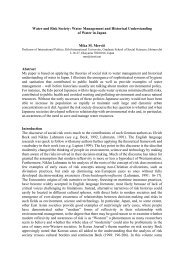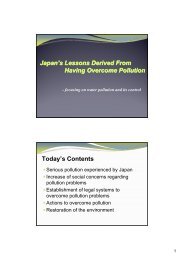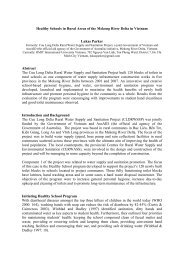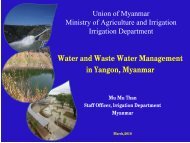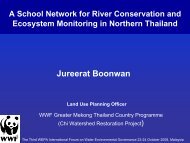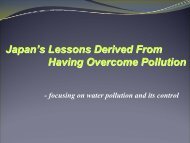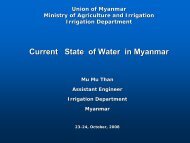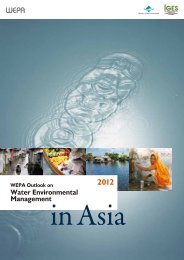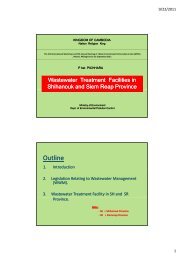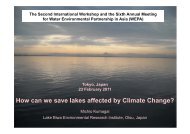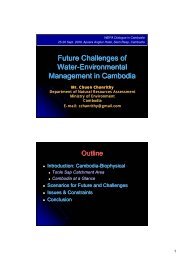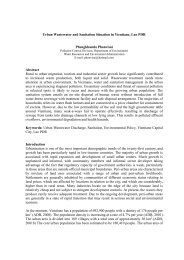OPERATION AND MANAGEMENT OF PUTRAJAYA LAKE & WETLAND - WEPA
OPERATION AND MANAGEMENT OF PUTRAJAYA LAKE & WETLAND - WEPA
OPERATION AND MANAGEMENT OF PUTRAJAYA LAKE & WETLAND - WEPA
Create successful ePaper yourself
Turn your PDF publications into a flip-book with our unique Google optimized e-Paper software.
Application of IWRM/IRBM Principles for Tasik Putrajaya CatchmentNormaliza Noordin., Mohammad Feizal Daud and Akashah Hj. MajizatEnvironmental, Lake and Wetland Division, City Planning Department,Perbadanan Putrajaya,62675 Putrajaya, Malaysia.AbstractIntegrated Water Resource Management (IWRM) principles, where the need of holistic andsystematic management approach is required, has been accepted by the MalaysianGovernment and these needs are already in the government policy statements such as in theRM8, RM9, OPP3 and the National Water Vission.The Federal Government has encouraged all state governments to establish its own watermanagement system i.e. in complying with the standard IWRM policies. The state of Kedahand Sabah has recently gazette their own water management act. The Selangor StateGovernment has already established the Lembaga Urus Air Selangor (River BasinManagement Authority) Enactment way back in 1999 to improve their river basinsmanagement.One of the river basins in Selangor which need a serious and systematic approach ofmanagement is the Putrajaya Lake Catchment. The planning, approval, monitoring andenforcement jurisdiction over all land development and human activities in this catchmentarea will have a direct impact to the Putrajaya Lake. The Lake is an urban lake, created rightin the middle of the newly developed Putrajaya, the Government Administrative City ofMalaysia.Putrajaya was planned to be developed into a “City in a Garden” with the 600 hectaresPutrajaya Lake and Wetland as its focal point. The lake has to be always in acceptable urbansetting condition with a high water quality level to cater its multi-functional uses such as forboating, fishing, recreational and water sport.This paper discusses the Putrajaya Lake Catchment system and the various mechanisms thathad been implemented for an effective and best result to ensure the high water quality level ofthe lake is continuously maintained. It also describes some problems in implementing aneffective catchment management.Keywords: Catchment management, Putrajaya lake and wetlands, management issues,implementation, enforcement, monitoring and funding.IntroductionThe Malaysian Government in its policy statements and other planning documents hasincluded the Integrated Water Resource Management (IWRM) approach as part of itsdevelopment programs. This holistic water management approach is already in thegovernment policy statements such as in the RM8, RM9, OPP3 and the National WaterVision.
All the State Governments had been encouraged to establish their own water managementsystem that complies with the standard IWRM policies. The states of Kedah and Sabah havegazetted their own water management act for this purpose. The Selangor State Governmenthad gazetted the Lembaga Urus Air Selangor (River Basin Management Authority)Enactment in 1999 to improve its river basins management.The Putrajaya Lake Catchment and LUASOne of the river basins in Selangor which need a serious and systematic managementapproach and control is the Putrajaya Lake Catchment.PAHANGSELANGORKUALALUMPURSUNGAI LANGATRIVER BASIN(IN SELANGOR)NEGERISEMBILANFigure 1. The Putrajaya Lake Catchment is only a small part of the bigger Sungai LangatRiver Basin.The Putrajaya Lake Catchment is a small river catchment of about 52.4km 2 (squarekilometers), located in the middle of Sungai Langat River Basin, 25 km south of KualaLumpur. It extends about 12 kilometers in the north to south direction and about 4.5 km in theeast to west direction.Figure 1 shows the location of this small catchment within the large Sungai Langat RiverBasin. In this small catchment area lies the Putrajaya City – the newly developed GovernmentAdministrative Center of Malaysia. The 600 hectares Putrajaya Lake is the focal point of this“City in a Garden”. The lake is use for activities such as recreational, boating, fishing andwater sport, in addition to enhancing the aesthetics of its waterfront characters.Even though it is an urban lake in the middle of a city, the Putrajaya Lake has always to be inits acceptable good water quality conditions to cater for its multi-functional uses.As an urban lake with active human activities around it, the planning, approval, monitoringand enforcement jurisdiction over all land development and human activities in its catchmentwill have a real and direct (normally negative) impact to the water quality and the lakecharacteristics.
The Putrajaya Lake integrated catchment managementWhy is it important to manage the catchment?Being a man-made lake in an urban setting, the Government recognizes that careful planningand management of the physical as well as the human issues within the catchment isnecessary.The task is to achieve and maintain The Putrajaya Lake Ambient Water Quality Standards(PLWQS) (which is of higher level than the DOE’s Interim Water Quality Standards of ClassIIB) and other objectives set for Putrajaya Lake and the allowable activities in it.One of the major issues is the control of development activities in the catchment. There is aneed to develop a pragmatic and implementable plan of action to ensure that the catchmentarea of Putrajaya Lake and the water resources within the catchment area are protected frompollution and the water quantity is maintained.Furthermore, the design objectives of the artificial wetlands were only to improve the waterquality of the surface runoffs flowing into the lake from the upstream areas. It was designedto treat only certain level of pollution loading i.e. the level of pollutant in the runoff should belimited to a certain acceptable level to enable the wetlands to function properly.In the year 2000, Perbadanan Putrajaya has developed the Catchment Development andManagement Plan (CDMP 2000) for Putrajaya Lake Catchment. This document is for easyreference to all stakeholders and it provides guidelines on the various methods/control toachieve and maintain the water quality level required for the Putrajaya Lake. The guidelinesalso define the land-use, drainage and sewerage master plans for the areas within the small butvery important catchment.Lembaga Urus Air Selangor (LUAS)The CDMP 2000 has clearly defined the role of LUAS in implementing its power to manage,control and enforce the necessary rules to the landowners and stakeholders within the 30% ofthe Putrajaya Lake Catchment area in Selangor.During the last eight (8) years of applying the CMDP 2000 guidelines, however, shows thatthe planning control for land use, drainage, environmental pollution control and coordinationtasks empowered to LUAS is not easily applicable and implemented by the agency.At the same time, realizing its role to ensure the success implementation of the IWRM andIRBM in the state, a strategic empowerment review of this organization is necessary to arrestvarious setbacks experience so far.Thus, the challenges face by LUAS can be defined which includes the following:• The problems are known;• The causes are often complex and the problems cannot be solved overnight;• The main task will include the decision on how to implement a successfulcoordination and programs agreeable by all stakeholders; and• The Putrajaya Lake Catchment is the testing ground of its capabilities to apply theIWRM principles to all other areas in Selangor.
Catchment Management Plan Policy StatementRecognizing the importance of careful planning and management control for the attainment ofthe city vision, Putrajaya Lake Catchment Management Plan need to be based upon thefollowing policies:i. Pollution control measure shall focus on the minimizations of pollutant generation atsource;ii. The drainage system shall base on vegetated landscape drainage corridors andconversion of flood detention and water quality enhancement ponds into miniwetlands;iii. The Putrajaya Wetland will be considered as an additional (last stage) water qualityenhancement or “polishing” mechanism. It will integrate with the upstream waterquality enhancement features, such as vegetated landscape riparian buffers, drainagecorridors and upstream mini-wetlands cum flood detention ponds.iv. Diversion or alteration of the natural drainage lines in the catchment shall not beallowed, however, improvement of its flow profile will be considered;v. All development activities in the catchment shall be in accordance with an agreeableand approved Catchment Development Land-use Master Plan.vi. All pertinent regulatory agencies shall coordinate (LUAS will play major role) theirfunctions and enforcement effort to attain the catchment management objectives andtargets;vii. Active participation of the catchment stakeholders and communities in themanagement of Putrajaya Lake;viii. Equitable sharing of the cost for the implementation of the catchment managementprograms including the maintenance cost shall be recovered based on the policyof ”the polluter pay” and “the direct beneficiaries pay”.ix. Realization of that, the cooperation and mutual agreement among all stakeholders inachieving the common goal of best water quality level of the surface runoff flowingthrough a catchment will be the best Integrated Water Resource Management outcome.The successful implementation of ICDMPThere is a need to update the CDMP 2000 to incorporate eight (8) years of implementationexperience and taking into consideration the latest policy, legal, current and future landuseplans of the catchment stakeholders. This will include the identification of the relevant clausesin the LUAS Enactment and develop the required institutional framework to enable LUAS towork with Perbadanan Putrajaya to protect Putrajaya Lake Catchment.The Review Strategyi. Development of institutional structure and identification of necessary legal provisionsin LUAS Enactment to enable management of the 30% of the Putrajaya LakeCatchment, which is in Selangor, to be upgraded to the same level as that implementedby Perbadanan Putrajaya;ii. Proposed institutional structure for managing the Putrajaya Lake Catchment, utilizingthe provision in the LUAS Enactment (e.g. Clause 56 that is to enable the PutrajayaLake Catchment to be a “Declared Catchment” with a management body involving allpertinent stakeholders);
iii. Legal guidelines to support LUAS and Perbadanan Putrajaya in implementing atransboundary catchment institutional framework, utilizing the existing provisions inthe LUAS Enactment, and other related laws;iv. Updating of CDMP 2000, so that an integrated lake catchment management andmonitoring system can be implemented by the developed institutional structureespecially by LUAS and its legal provisions; andv. Info-sharing among catchment’s stakeholders to support Integrated CatchmentManagement System (ICMS)vi. Effective telemetry system to enable real-time, remote measurement and reporting oflake catchment monitoring information centre.Aspects of Management and PlanningThe CDMP 2000 review will cover the details for the integrated regulatory control for theareas outside Putrajaya especially on the following aspects:a) Planning and Land-use Control;b) Drainage Planning and Water Quantity Management;c) Sewerage Planning;d) Environmental Management and Water Quality;e) The Lake and Wetlands;f) The information System study; andg) Legal and Coordination Between Regulatory AgenciesThe management scopes and its recommendations for review on various aspects are as inAppendix A.Organisation and coordination structureAdministrative JurisdictionThe catchment lies within the administrative jurisdiction of the Majlis Daerah Sepang (MDS),Majlis Perbandaran Subang Jaya (MPSJ) and PPj. Figure 3 shows the Northern area ofPutrajaya Catchment boundaries. The stakeholders in the Putrajaya Lake Catchment are:i. Universiti Putra Malaysia (UPM);ii. Malaysian Agricultural Research Development Institute (MARDI);iii. Industrial Oxygen Incorporated Bhd. (IOI);iv. West Country Sdn. Bhd. (WEST);v. Universiti Tenaga Nasional (UNITEN);vi. Sungai Merab Malay Reserve (SMMR);vii. Cyberjaya Flagship Zone - Phase 2B (CFZ), andviii. Putrajaya.
CatchmentBoundaryMARDIUPMTNBIOIWESTUNITENCFZSMMRFigure 3. Upper Part of Putrajaya Lake Catchment (30% of the Lake’s Catchment is notunder the jurisdiction of Perbadanan Putrajaya)Implementation requirementsi. Successful implementation requires co-ordination, co-operation and collaborationbetween existing planning authorities and between different interest groups andstakeholders.ii. CDMP is more than a technical and engineering solution to catchment management,providing a platform for integration of various stakeholders’ interest, besidesestablishing an overall guidance for consistent implementation of policies.iii. Legislative and institutional framework has to be put in place first to establish thediscipline and direction.iv. It is necessary to establish a mechanism that can merge co-ordination and seek cooperationnot only across sectors, but also political and administrative borders.The Catchment Development and Management CommitteeIn keeping up with the catchment development on-going progresses, cooperation andcoordination amongst the stakeholders together with the implementation of variousregulations and control of land development and human activities, A Federal and State intergovernmentcommittee consisting of officers from different government agencies, localauthorities and stakeholders will need to be established.Known as the Putrajaya Lake Catchment Management Committee (PLCMC) asrecommended by the CDMP 2000, the formation of this committee will be in accordance tothe Selangor Waters Management Authority Enactment (SWMAE, 1999).The earlier recommended committee chaired by the State Secretary of Selangor (as listed inAppendix B) with Lembaga Urus Air Selangor (LUAS) and Bahagian Tasik PerbadananPutrajaya as the joint-secretariat, however, has no legal powers. Thus, to facilitate themonitoring and implementation of legislative enforcement of the catchment area, a legallyconstituted Management Committee is to be formed under the SWMAE (1999).
To expedite the legal process in implementing, monitoring and enforcement of the SWMAE(1999) Act, Perbadanan Putrajaya and the Selangor State Government through LUAS ispreparing the formulation of the “Study on Operationalisation of LUAS’s 1999 Enactment forInstitutional Development and Integrated Catchment Management for Putrajaya, 2008”ConclusionThe success of the implementation of an Integrated Catchment Management especially for anurban catchment depends largely on the cooperation and coordination between thestakeholders (landowners), government agencies and the local authorities involved.Although through the cooperation of LUAS, MPSJ, MDS and Perbadanan Putrajaya, theexisting by-laws and guidelines can be executed within the CMDP, the real challenge iswhether the authorities can work together with all the landowners and stakeholders for acommand goals of achieving a predetermined water quality of a lake.The success, however, will be seen more effectively whereby the by-laws and guidelines iscarried out by all the stakeholders of the lake catchment voluntarily for the benefit ofeverybody within the catchment.The practical application of this arrangement will also be a showcase of our legislativeframeworks and the much-awaited effective solutions for the use of all the other water basinsmanagement for the whole of Malaysia.ReferencesAkashah, M., (2003) Operation and Management of Putrajaya Lake and wetlands. NationalSeminar on Constructed Wetlands 2003, December 2003. Putrajaya.A. Salleh, A. Halim Sulaiman, A.R.Abdullah, J. Lalung, H. Mohd. Ali, N. Mohd Khalid, S.Nazri (2003) Problems of Euglena Bloom in Putrajaya Wetlands. National Seminar onConstructed Wetlands 2003, December 2003. Putrajaya.Department of Irrigation and Drainage Malaysia (2001). Urban Stormwater ManagementManual for Malaysia (Manual Saliran Mesra Alam Malaysia).Majlis Daerah Sepang (2000). Draf Rancangan Tempatan Sg. Merab (Tele Suburb) 2000 –2015 Jilid I (Peta Cadangan dan Pernyataan Bertulis) dan II (Garispanduan Pembangunan).Perbadanan Putrajaya (1997). <strong>PUTRAJAYA</strong> – Review of the Masterplan.Perbadanan Putrajaya (2000). Catchment Development and Management Plan for PutrajayaLake (Volume 1 – Main Report).Zaharah, S. (2004) Putrajaya Lake Catchment Management – A Case Study. ConferenseManaging Rivers, August 2004..
Appemdix A: Catchment Management Scope Review and RecommendationsSCOPE DESCRIPTION RECOMMENDATIONWater QualityManagementWater QuantityManagementDrainage PlanningThe current water quality in the lake iswithin the permissible values of PutrajayaLake Water Quality. It is recognized that themost effective way to attain the desired waterquality objective is to minimize thegeneration of pollutants at their source. Also,it is recognized that erosion and transport ofsediment during the land clearing,earthworks and construction phase pose avery serious threat to lake water quality.It is important that all possible runoff arisingfrom lake catchment should enter into theLake system. Also, there should be propercontrol over the amount of water drawn forirrigation or other purposes and no diversionor alteration of the natural drainage lines inthe catchment is to be allowed.The drainage Masterplan comprises ofDrainage Planning and Design Guidelines.To manage pollutants at source.The drainage system should be based on vegetated landscaperiparian buffers, drainage corridors and mini-wetlands waterquality enhancement ponds.To prevent the entry of rubbishGross pollutant/sediment trap (GPT) structures are to beinstalled at the ends of all concrete drains flowing into thevegetated landscape drainage corridors.To ensure effective control of erosion and sediment duringearthworks.It is recommended that a new “Erosion And Sediment ControlBy Law” be enacted by Putrajaya Corporation and MajlisDaerah Sepang. The recommended By- Law should besupported by a new “Standards For Erosion And SedimentControl” Manual.Compensation flow equal to 10% of the Annual Average Flowmay be allowed during the in-filling of the main dam.A well field of 6 groundwater wells can be developed,downstream of the main dam, to supply 0.013 m3/s (10,000g/hr) of groundwater to meet any water demand.A separate irrigation masterplan study on the impact of theproposed rainwater harvesting within the catchment on thewater quantity in the lakeDrainage planning and Design Guidelines based on thevegetated drainage corridor concepts.Specific recommendations for upgrading the drainage systemsin UPM, MARDI, IOI, West Country and CyberjayaPollutant SourcesManagementThe sewage effluent discharge from outsidehave been identified as the major pointsource pollutant. They are controlled in thesewerage masterplan.Accident associated with the oil tankersmoving along the road passing through thewetlands can be a major point sourcepollutant. Thus, the pertinent authorities(JKR, Putrajaya Corporation) has to ensurethat Emergency.Response Plans and Procedure are preparedand implemented to handle such potentialemergencies.THE ISSUESIn-stream discharges from UPM and MARDIlocated north of Putrajaya Lake CatchmentArea (sewerage discharges, treatment plant,septic tank system)Discharges from point and non-point sourcesof various types of pollutants fromagriculture, institutions, commercial areas,golf course, residential areas, power station,health facility and parksThe wetland cells( point and non-point pollutant source)Existing and future landuse type andpollution potentialsThe main lakes and outletsNon-point pollutant sources from road runoffs are to becontrolled through the implementation of the drainage systembased on vegetated drainage corridor. Those from fertiliser andpesticide input from MARDI, UPM, IOI, and Cyberjaya are tobe controlled by regulatory measures using the prepared MPguidelines on the use of fertilizer and pesticides.To improve the quality of water entering into Putrajaya LakeTo ensure Putrajaya Lake and water resource areas are protectedfrom pollutionTo streamline and improve on the efficiency of monitoring,observation and enforcement of water quality in the PutrajayaLake BasinTo enhance the overall environment
SCOPE DESCRIPTION RECOMMENDATIONLand-useLanduse IssuesPlanningTo ensure that the development in the aboveareas are in line with the objectives for thecatchment a land-use masterplan has beenprepared.Detailed review of any changes or deviationsbetween current landuse and landuse in theCDMPPL, 2000An evaluation of the committed projects thathave come into effect since the publication ofthe CDMPPL (Perbadanan Putrajaya, 2000)Updated GIS generated maps showing thecurrent landuse scenarioSustainability of the landuselanduse positions of major stakeholders (shares of the PutrajayaLake catchment)identify and evaluate sensitive issues of physical developmentLanduse Policies and GuidelinesStructure and Local Plans used:-Selangor Structure Plan;Putrajaya Structure PlanSepang Local Plan; andSubang Jaya Local Plan.Putrajaya Landuse MasterplanPutrajaya Urban Design Guidelines (UDG)Multimedia Super Corridor (MSC) - The plan should beincorporated in MSC areas Local Plan that is currently beingprepared by JPBD.Planning and LanduseControlSewerage PlanningDrainageManagement andControlPlanning and land use control of areas withinthe catchment represents one of the mostimportant mechanisms for the protection ofthe water quality in the lake. The mechanismand set-up for control and management ofplanning in Majlis Daerah Sepang (MDS)and Majlis Perbandaran Subang Jaya(MPSJ)is not as well organized as in Piutrajaya.The major land parcels in the catchmentareas outside Putrajaya are UPM, MARDI,IOI, TNB, West Country, UNITEN,Cyberjaya and the Sg. Merab Malay Reserve.The sewerage masterplan comprises ofSewerage Planning and Design Guidelines:There is no integrated approach to this issuesince the responsibilities for drainage lieswith JPS, local authorities and other agenciessuch as JKR and other developers.To develop and gazette local plans for the land parcels outsidePutrajaya. This will be carried out by JPBD as part of local planfor MSC Area.To implement similar planning submission and approvalprocess requirement similar planning submission and approvalprocess requirement as those in Putrajaya Corporation, for allproposed development projects in the catchment areas of MajlisDaerah Sepang (MDS).Specific recommendations for the management of the sewageeffluent discharge from MARDI,UPM, IOI and Cyberjaya.To require all development projects, including utilities andtransportation projects to comply with the recommendeddrainage concept and design guidelines for the Putrajaya Lakecatchment.To assign an additional Civil Engineer and Technical Assistantto MDS so that they can give special attention to drainage andearthworks for developments in the Putrajaya Lake catchmentareas.
Appendix B: The Putrajaya Lake Catchment Management Committee (PLCMC) asrecommended by the CDMP 2000The designations of the committee are as follows:Chairman:Selangor State SecretarySecretariat: LUAS/The Lake Unit, Perbadanan Putrajaya;Members:i. Selangor Waters Management Authority (LUAS),ii. Jabatan Pengairan dan Saliran (JPS),iii. Jabatan Alam Sekitar (JAS),iv. Jabatan Perancangan Bandar dan Desa (JPBD),v. Jabatan Kerja Raya (JKR),vi. Jabatan Perkhidmatan Pembentungan (JPP),vii. Majlis Perbandaran Subang Jaya (MPSJ),viii. Majlis Daerah Sepang (MDS),ix. Perbadanan Putrajaya (PPj),x. Representative of Stakeholder’s Consultative Committee



